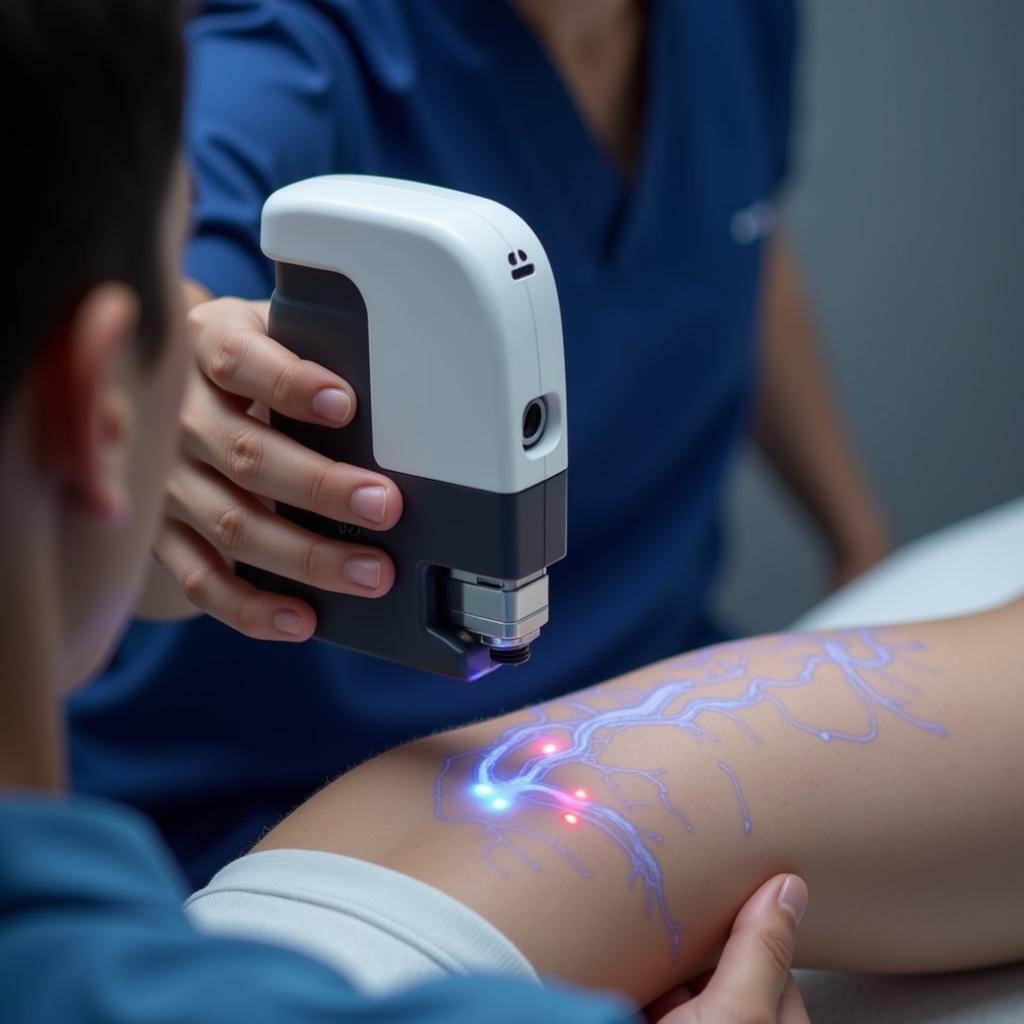Hospital Grade Vein Finders are transforming the way healthcare professionals locate and access veins, leading to improved patient care and treatment outcomes. These devices utilize cutting-edge technology to provide clear and accurate vein visualization, even in challenging patients. This guide delves into the world of hospital grade vein finders, exploring their benefits, applications, and factors to consider when choosing the right one for your needs.
 Advanced Vein Visualization Technology
Advanced Vein Visualization Technology
Understanding the Importance of Effective Vein Visualization
Locating and accessing veins can be a difficult task, especially in patients with dark skin tones, obesity, or other conditions that make veins hard to see. Traditional methods of vein visualization often rely on palpation and visual assessment, which can be subjective and lead to unsuccessful venipuncture attempts. These unsuccessful attempts can cause pain, anxiety, and complications for patients, while also increasing healthcare costs and staff frustration.
The Advantages of Hospital Grade Vein Finders
Hospital grade vein finders offer a significant advantage over traditional methods by providing a clear and accurate image of the subcutaneous vasculature. This enhanced visibility allows healthcare professionals to:
- Improve First-Stick Success Rates: By clearly identifying the location, size, and depth of veins, these devices increase the likelihood of successful venipuncture on the first attempt.
- Reduce Pain and Anxiety: Successful first-stick attempts minimize patient discomfort and anxiety associated with multiple needle sticks.
- Enhance Patient Safety: Accurate vein visualization reduces the risk of complications such as nerve damage, hematomas, and extravasation.
- Improve Workflow Efficiency: Streamlined venipuncture procedures save valuable time for both healthcare professionals and patients.
Applications of Hospital Grade Vein Finders
The versatility of hospital grade vein finders makes them suitable for a wide range of medical applications, including:
- Venipuncture: Drawing blood for diagnostic testing or blood donation.
- Intravenous (IV) Therapy: Administering medications, fluids, and blood transfusions.
- Sclerotherapy: Treating varicose and spider veins.
- Cosmetic Procedures: Assisting with procedures such as dermal fillers and Botox injections.
Factors to Consider When Choosing a Hospital Grade Vein Finder
Selecting the right vein finder for your specific needs depends on several factors:
- Imaging Technology: Different vein finders utilize different technologies, such as near-infrared light, transillumination, or a combination of both. Each technology has its strengths and weaknesses, and the best choice will depend on your typical patient population and clinical applications.
- Image Quality and Resolution: High-resolution images provide greater detail, making it easier to differentiate between veins, arteries, and surrounding tissue.
- Portability and Ease of Use: Consider the device’s weight, size, and user interface. A portable and user-friendly vein finder can enhance workflow efficiency, especially in busy clinical settings.
- Durability and Battery Life: Choose a device built to withstand the demands of a healthcare environment with a long battery life to minimize interruptions.
- Cost and Warranty: Evaluate the overall value proposition, including the purchase price, warranty coverage, and potential maintenance costs.
“Investing in a high-quality vein finder is an investment in patient care,” says Dr. Sarah Thompson, a leading phlebotomist with over 20 years of experience. “It not only makes our jobs easier but significantly improves the patient experience by minimizing discomfort and ensuring accurate and efficient procedures.”
Conclusion
Hospital grade vein finders are revolutionizing vein visualization and transforming patient care. By enabling healthcare professionals to accurately locate and access veins, these devices offer numerous benefits, including increased first-stick success rates, reduced pain and anxiety, enhanced patient safety, and improved workflow efficiency. When choosing a vein finder, carefully consider factors such as imaging technology, image quality, portability, durability, and cost to ensure you select the best device for your specific needs and budget. Embracing this advanced technology can significantly enhance the quality of care you provide to your patients.
FAQs
Q: Are hospital grade vein finders safe for all patients?
A: Yes, hospital grade vein finders are generally safe for all patients, including pregnant women and children. The technology used emits non-invasive light that does not pose any known health risks.
Q: Can vein finders be used on patients with tattoos?
A: While vein finders can be used on patients with tattoos, the ink can sometimes interfere with the device’s ability to visualize veins. It may be necessary to scan around the tattoo area to find a suitable vein.
Q: How often do vein finders need to be calibrated?
A: Most hospital grade vein finders do not require frequent calibration. However, it’s essential to follow the manufacturer’s recommendations for maintenance and calibration to ensure optimal performance.
Q: What is the average lifespan of a hospital grade vein finder?
A: With proper care and maintenance, a high-quality hospital grade vein finder can last for several years.
Q: What are the training requirements for using a vein finder?
A: While vein finders are relatively easy to use, proper training is essential to ensure accurate and safe operation. Training is typically provided by the manufacturer or distributor.
Need Help Choosing the Right Vein Finder?
Contact us at Phone Number: 02437655121, Email: [email protected], or visit our address: No. 298 Cau Dien Street, Minh Khai, Bac Tu Liem, Hanoi, Vietnam. Our team of experts is available 24/7 to provide personalized guidance and support.